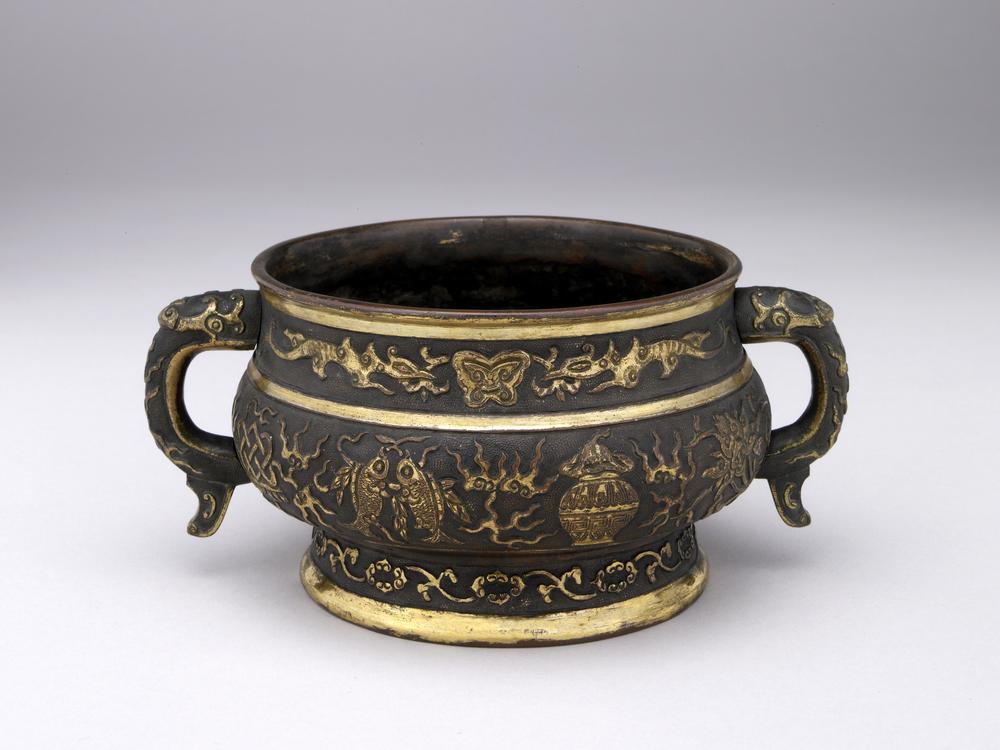Period:Five Dynasties and Ten Kingdoms Production date:10thC
Materials:silk, 絲綢 (Chinese),
Technique:painted
Subjects:buddha 佛 (Chinese) 供養人 (Chinese)
Dimensions:Height: 64.60 centimetres Width: 39.40 centimetres
Description:
Painting of a seated Buddha with hands in the vitarka-mudra (gesture of reasoning or discussion), and therefore possibly Maitreya or Amitābha. The whole figure, with nimbus and aureole, is set within a large white circle. Two donor figures on either side of a central blank catrouche. Ink and colour on silk.
IMG
![图片[1]-painting; 繪畫(Chinese) BM-1919-0101-0.30-China Archive](https://chinaarchive.net/Five Dynasties and Ten Kingdoms/Paintings/mid_RFC634.jpg)
![图片[2]-painting; 繪畫(Chinese) BM-1919-0101-0.30-China Archive](https://chinaarchive.net/Five Dynasties and Ten Kingdoms/Paintings/mid_RFC634_1.jpg)
![图片[3]-painting; 繪畫(Chinese) BM-1919-0101-0.30-China Archive](https://chinaarchive.net/Five Dynasties and Ten Kingdoms/Paintings/mid_RFC634_2.jpg)
Comments:EnglishFrom Whitfield 1983:The Buddha is shown seated in Western fashion with his legs pendent. He may be Maitreya, although, as Waley pointed out, this variant of vitarka-mudra properly belongs to the second of the nine Amitabhas who preside over the Sukhavati. The whole figure with aureole and nimbus is set within a whitened circle, edged in red that nearly fills the width of the painting. This setting and the proportions of the composition, as well as the flowers in the upper corners, link it with the painting of Ksitigarbha (Pl. 8); the execution is however much coarser, and both the style of the figure and the costumes of the donors, with exaggeratedly stiff and long cap ribbons, suggest a somewhat later date, no earlier than the middle of the tenth century.The painting is surrounded by its original broad border of red cotton in a 2:1 twill. As in the preceding plate, the spaces for the inscription and for the name of the Buddha are left blank, suggesting that this was a painting executed in anticipation, but never actually bought or brought into devotional use. This raises the possibility that paintings bearing dates may in some cases have been executed a few years earlier than the actual date recorded. ChineseFrom Whitfield 1983:此如來表現的是兩腿下垂的倚像。Waley認爲此像的印是說法印的變形,正確說法應該是極樂淨土的主宰者阿彌陀如來的九品印的第二個,即上品中生印,該像大概表現的是彌勒。包括身光和頭光的全身,被收攏在幾乎占滿畫面左右的巨大白色圓相中,圓相被赤茶色線括起。這種構圖方式,包括畫面兩上角配飾的花朵,與圖8的地藏菩薩像相似。但從描繪比它粗糙,主尊的像容、戴硬腳襆頭的供養人的衣裳等看,其年代更晚些,大概不會晚於10世紀中葉。繪畫邊緣有經緯線2比1斜紋織的寬幅紅色棉布邊兒。和上圖一樣,題記欄和記錄像名的長方形題箋框依然是空欄。這是因爲,繪畫是預先製作的,估計未出現購買者或捐錢者。如果是那樣,倒是可以說在有紀年的繪畫中,包含很多比實際紀年早許多年製作的繪畫。
Materials:silk, 絲綢 (Chinese),
Technique:painted
Subjects:buddha 佛 (Chinese) 供養人 (Chinese)
Dimensions:Height: 64.60 centimetres Width: 39.40 centimetres
Description:
Painting of a seated Buddha with hands in the vitarka-mudra (gesture of reasoning or discussion), and therefore possibly Maitreya or Amitābha. The whole figure, with nimbus and aureole, is set within a large white circle. Two donor figures on either side of a central blank catrouche. Ink and colour on silk.
IMG
![图片[1]-painting; 繪畫(Chinese) BM-1919-0101-0.30-China Archive](https://chinaarchive.net/Five Dynasties and Ten Kingdoms/Paintings/mid_RFC634.jpg)
![图片[2]-painting; 繪畫(Chinese) BM-1919-0101-0.30-China Archive](https://chinaarchive.net/Five Dynasties and Ten Kingdoms/Paintings/mid_RFC634_1.jpg)
![图片[3]-painting; 繪畫(Chinese) BM-1919-0101-0.30-China Archive](https://chinaarchive.net/Five Dynasties and Ten Kingdoms/Paintings/mid_RFC634_2.jpg)
Comments:EnglishFrom Whitfield 1983:The Buddha is shown seated in Western fashion with his legs pendent. He may be Maitreya, although, as Waley pointed out, this variant of vitarka-mudra properly belongs to the second of the nine Amitabhas who preside over the Sukhavati. The whole figure with aureole and nimbus is set within a whitened circle, edged in red that nearly fills the width of the painting. This setting and the proportions of the composition, as well as the flowers in the upper corners, link it with the painting of Ksitigarbha (Pl. 8); the execution is however much coarser, and both the style of the figure and the costumes of the donors, with exaggeratedly stiff and long cap ribbons, suggest a somewhat later date, no earlier than the middle of the tenth century.The painting is surrounded by its original broad border of red cotton in a 2:1 twill. As in the preceding plate, the spaces for the inscription and for the name of the Buddha are left blank, suggesting that this was a painting executed in anticipation, but never actually bought or brought into devotional use. This raises the possibility that paintings bearing dates may in some cases have been executed a few years earlier than the actual date recorded. ChineseFrom Whitfield 1983:此如來表現的是兩腿下垂的倚像。Waley認爲此像的印是說法印的變形,正確說法應該是極樂淨土的主宰者阿彌陀如來的九品印的第二個,即上品中生印,該像大概表現的是彌勒。包括身光和頭光的全身,被收攏在幾乎占滿畫面左右的巨大白色圓相中,圓相被赤茶色線括起。這種構圖方式,包括畫面兩上角配飾的花朵,與圖8的地藏菩薩像相似。但從描繪比它粗糙,主尊的像容、戴硬腳襆頭的供養人的衣裳等看,其年代更晚些,大概不會晚於10世紀中葉。繪畫邊緣有經緯線2比1斜紋織的寬幅紅色棉布邊兒。和上圖一樣,題記欄和記錄像名的長方形題箋框依然是空欄。這是因爲,繪畫是預先製作的,估計未出現購買者或捐錢者。如果是那樣,倒是可以說在有紀年的繪畫中,包含很多比實際紀年早許多年製作的繪畫。
© Copyright
The copyright of the article belongs to the author, please keep the original link for reprinting.
THE END
![[Qing Dynasty] British female painter—Elizabeth Keith, using woodblock prints to record China from the late Qing Dynasty to the early Republic of China—1915-China Archive](https://chinaarchive.net/wp-content/uploads/2022/11/image-191x300.png)




